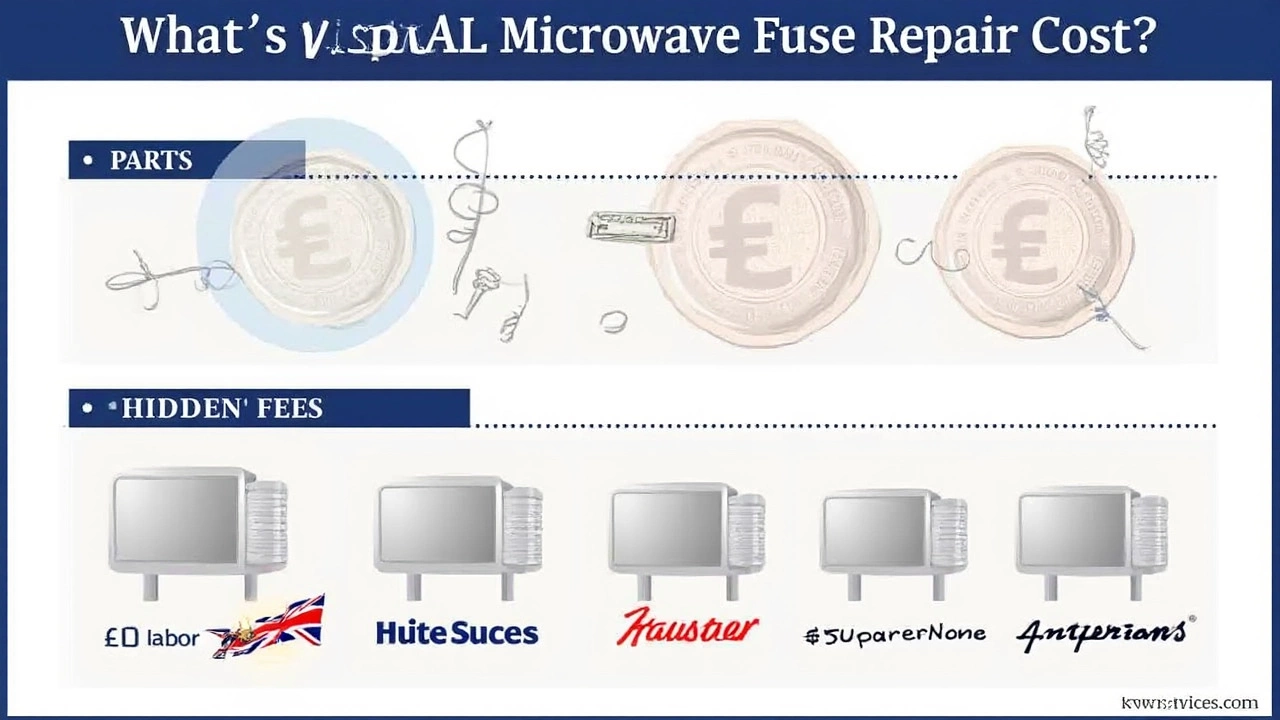Microwave not turning on, not lighting up, or acting like it’s completely dead? Nine times out of ten, the culprit is a tiny, cheap fuse buried inside. Some folks panic and toss the whole thing, but honestly, a blown microwave fuse is one of the most common (and fixable) problems out there.
Here’s the kicker—not all fuses are created equal. A basic replacement fuse costs just a couple bucks. But here’s what trips people up: labor can quickly make that price skyrocket if you’re paying a repair shop. No one likes surprise bills just for a five-minute fix.
Knowing the real numbers, what drives up those costs, and what shortcuts you can safely take will save you cash and hassle. I’ll share what usually goes wrong, what repair shops actually charge (no sugarcoating), and which microwave brands are budget-friendlier when it comes to simple repairs like this.
- Signs Your Microwave Fuse Is Blown
- Fuse Types and Why They Matter
- Repair Cost Breakdown: Parts and Labor
- DIY vs. Professional Repair
- Can You Prevent Future Fuse Blows?
- Is It Worth Repairing or Just Replacing?
Signs Your Microwave Fuse Is Blown
If you’re dealing with a microwave that just won’t turn on—no lights, no sound, nothing—you might have a blown fuse on your hands. This is actually the most common issue people run into with their appliance. But how do you tell if it’s really the fuse and not something more serious?
Here’s what usually happens when a fuse goes:
- The microwave is totally dead. The display is off. Pressing any button does nothing. It acts like it isn’t even plugged in.
- Sometimes you’ll hear a loud “pop” or notice a burning smell right before the microwave shuts off. That’s a classic fuse blow moment, and trust me, you’ll know when it happens.
- If your kitchen power outlets are fine and other gadgets work there, but only the microwave is unresponsive, the fuse is a likely suspect.
Microwave fuses are safety devices—they cut the power when something inside overheats or there’s a power surge. That’s why you can’t just keep pressing buttons and hoping for a miracle.
There are a few types of fuses in most models: the main ceramic fuse, thermal fuses, or thermal cutoffs. Most of the time, it’s that main ceramic one that blows. If you pop open the microwave (after unplugging it), you’ll see a small, cylindrical part near where the power cable connects inside. If that little guy looks blackened or the wire inside is broken, you’ve found your problem.
Sometimes folks confuse a blown fuse with a door switch problem or a tripped circuit breaker. To be sure, check that other outlets work and your home breaker isn’t tripped. If all that checks out but your microwave repair still isn’t firing up, the fuse is probably toast.
Fuse Types and Why They Matter
Don’t get fooled into thinking all microwave fuses are the same. There are a few different types, and the one your microwave uses can change the repair cost and how tricky the job is. If you swap in the wrong fuse, you’re wasting cash and probably setting yourself up for more headaches—not to mention fire hazards.
The most common fuses you’ll run into are:
- Ceramic fuses: These are the big workhorses, found in most modern microwaves. They handle high voltage and heat, so they’re reliable. You’ll usually see them labeled as 20-amp or 15-amp.
- Glass tube fuses: These are clear, so you can spot a blown one right away. Mostly found in older microwaves or smaller countertop models. Not as tough as ceramic.
- Thermal fuses: These are a backup safety thing, meant to cut the power if your microwave gets too hot. If this one goes, it automatically means something else ran way too hot inside.
Never just grab any old fuse from the hardware store. The amps and voltage ratings must match exactly what the microwave demands, or your repair could turn into a repeat nightmare or even a safety risk. Look for the numbers on the old fuse—even write them down before shopping. Online, you can usually find replacement fuses for under $10, but stores like Home Depot or Lowe’s might charge a bit more for convenience.
Here’s a quick look at typical fuse prices by type and where they’re found:
| Fuse Type | Common Rating | Average Price (USD) | Microwave Types |
|---|---|---|---|
| Ceramic | 15A / 20A | $2 - $8 | Most modern, built-in, over-the-range models |
| Glass Tube | 10A / 15A | $1 - $5 | Older, smaller countertop models |
| Thermal Fuse | Varies | $6 - $15 | All types, used for temperature safety |
Bottom line? Paying attention to the exact fuse type and rating not only saves money but also keeps your appliance (and your kitchen) safe. When you see generic fuse packs, walk away. Always match the specs, and if the microwave repair guy says “close enough,” that’s a red flag. The right fuse is the difference between a quick fix and a repeat trip to the repair shop.
Repair Cost Breakdown: Parts and Labor
Let’s get right to the point: replacing a microwave fuse isn’t expensive if you’re only looking at parts. A standard fuse—sometimes labeled as a ceramic fuse or a thermal fuse—usually costs between $2 and $10 at most hardware stores or online. Even high-end or brand-specific fuses rarely go above $15. If you bring your old fuse to the store or match the numbers stamped on it, there’s not much risk of grabbing the wrong one.
Where it gets tricky is the labor. If you know your way around a screwdriver, it’s a five-minute job. But hiring a repair tech can turn this tiny fix into a $60–$120 expense. That’s because most appliance shops charge a minimum fee just for showing up—usually called a “diagnostic fee”—plus labor that can hit $50 an hour. In 2025, you’ll see that number sometimes creep up even higher in busy metro areas.
- Microwave repair shops often bundle labor and diagnostic costs together, so always ask up front what’s included in the quote.
- Big brand service providers like Sears or Best Buy may have higher callout charges than local repair guys, sometimes by $40 or more.
- Warranty? You might get the fuse swapped for just the part cost—otherwise, you’re paying full price.
If you add it all up, here’s what the usual bill looks like:
- Fuse: $2–$10
- Labor/diagnostic fee: $60–$120
- Total repair cost (pro): generally $70–$130
Now, if your microwave is built-in or has a complicated design, those numbers can edge higher, since it takes longer to pull it out and reassemble. Sometimes, shops might even recommend just replacing the whole unit if it’s an older, budget model.
The bottom line: the fuse is dirt cheap; it’s the labor that bites. Knowing that up front helps you decide if you want to do it yourself or pay for the convenience of a pro.

DIY vs. Professional Repair
Thinking about fixing your microwave fuse yourself? You’re not alone. A lot of people wonder if it’s really worth paying a pro, especially when a replacement fuse rarely costs more than $5, even for name brands like GE or Panasonic. If you have a Phillips screwdriver, half an hour, and some patience, you’re most of the way there. But—there’s a real safety risk if you’re not careful.
First, microwaves have high-voltage capacitors that can shock you even when unplugged. That’s why some manufacturers (Samsung especially) warn clearly against DIY repairs. For people with zero experience inside appliances, it’s safest to pass this one to someone trained.
If you’re comfortable moving carefully, here’s how the costs usually shake out when you compare DIY and professional routes:
| Repair Type | Typical Cost | Time Needed |
|---|---|---|
| DIY Fuse Replacement | $3 - $15 | 20 - 40 min |
| Professional Repair | $60 - $130 (incl. labor & call-out fee) | 1 - 3 days (with pickup & return) |
Going DIY? Here’s what you’ll need to do:
- Unplug the microwave. Wait at least 30 minutes to let the charge drain.
- Remove the outer cover (usually a few screws at the back or sides).
- Locate the fuse—most models have it near the power cord inlet.
- Check the rating on the bad fuse. Grab an exact match (most big-box stores carry them—in a pinch, you can find fuses at auto parts stores, too).
- Pop in the new fuse, making sure it clicks solidly in. Reassemble everything and test.
One thing to remember: if the new fuse blows again right away, that points to a deeper problem (like a faulty door switch or shorted transformer). At that point, step back and let a pro take over since fixing internals can get dicey.
Sometimes, a quick call to a microwave repair shop will get you a free quote. Some techs even offer mobile service, coming to your kitchen for an extra $20–$50. If your microwave is a basic countertop model, most folks agree—DIY is a win as long as you keep safety first. For built-in or over-the-range models, or those with digital quirks, pro repair might save you in the long run.
Can You Prevent Future Fuse Blows?
You can’t make microwave fuses last forever, but you can stretch out their life with some smart habits. A fuse usually goes because it’s doing its job—protecting the microwave from a power surge or an electrical short. But sometimes we accidentally make things worse without even realizing it.
First off, avoid running your microwave empty. That quick beep-beep cycle with nothing inside seems harmless, but it actually bounces microwaves back into the machine, stressing the fuse and other parts. Another one: don’t slam the door. That can jostle internal connections and slowly wear out the circuitry, putting extra pressure on the fuse.
Here’s what else makes a big difference:
- Plug your microwave into a dedicated outlet—don’t share it with the fridge or other big appliances. Overloading a circuit is the fastest way to fry a fuse.
- If you live somewhere with unstable power, consider getting a surge protector. It’s cheap insurance compared to weekly fuse replacements.
- Always use cookware that's labeled microwave-safe. Metal or hidden foil can cause arcing, basically mini lightning bolts inside, which might blow the fuse.
- Clean the inside regularly. Built-up grime or steam hitting the vents can mess with the electronics and lead to blown fuses.
Peeking at brand-new microwaves, manufacturers claim their fuses should last the lifetime of the unit—usually about 7-10 years. But check out this quick table for what actually happens in most households:
| Microwave Age Group | Chance of Blown Fuse Annually |
|---|---|
| Less than 3 years | Under 5% |
| 3-6 years | 15% |
| Over 6 years | 35% |
If your fuse blows more than once a year, it’s not normal. At that point, something else could be wrong, like a bad door switch or a failing magnetron. Fixing the fuse alone is just a short-term bandage.
In short, keep things clean, avoid power surges, and treat your microwave right. Paying attention to these little basics can keep that microwave repair bill down and help your machine run better for longer.
Is It Worth Repairing or Just Replacing?
This is the question just about everyone asks when their microwave kicks the bucket. And honestly, it’s not always worth shelling out for a repair. The answer depends a lot on what you paid for your microwave, what’s wrong with it besides the fuse, and if you mind getting your hands a little dirty for a simple swap.
Let’s look at some real numbers. The average cost for a basic microwave repair (fuse only, no extra labor) usually runs between $50 and $100 at most shops, including the part. If a repair person comes to your house, tack on another $30 to $80 for the house call. Fancy microwaves or built-ins? Those can get closer to $150 or more, depending on where you live and what brand you own.
| Repair Option | Average Cost (USD) |
|---|---|
| DIY – New fuse only | $2 – $15 |
| Repair shop (carry-in) | $50 – $100 |
| Professional at-home visit | $80 – $150 |
| Buying new mid-range microwave | $120 – $250 |
| Buying new high-end/built-in | $300 – $1000+ |
If your microwave was cheap when you bought it (say, $80 or less), and you have to pay someone to fix it, it’s probably smarter to just buy a new one. There’s no reason to drop $100 to fix an old $70 machine, unless it’s got sentimental value.
Here’s when repairing makes sense:
- Your microwave is fancy, built-in, or matches your other kitchen stuff
- The repair is literally just replacing the fuse (not a deeper electrical issue)
- You’re able to do the fuse swap yourself, so the fix only costs you the part
Don’t forget about warranty. Most microwaves come with a 1-year warranty, and some premium brands cover parts for longer. If you’re still in that window, call the company—don’t spend a dime for a simple repair they’ll handle for free.
One last thing—if the microwave’s been acting weird (like sparking, making odd noises, or not heating consistently), a blown fuse might just be a symptom, not the real problem. Throwing money at just a fuse replacement won’t help if something bigger is toast inside. Sometimes, it’s less headache to just spring for a new unit and call it a day.




